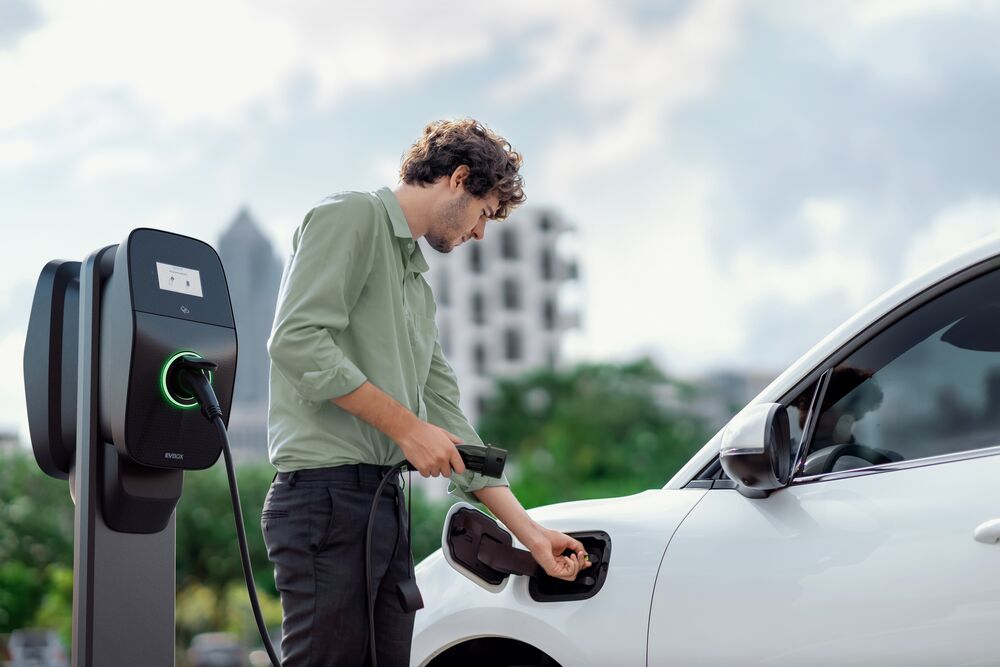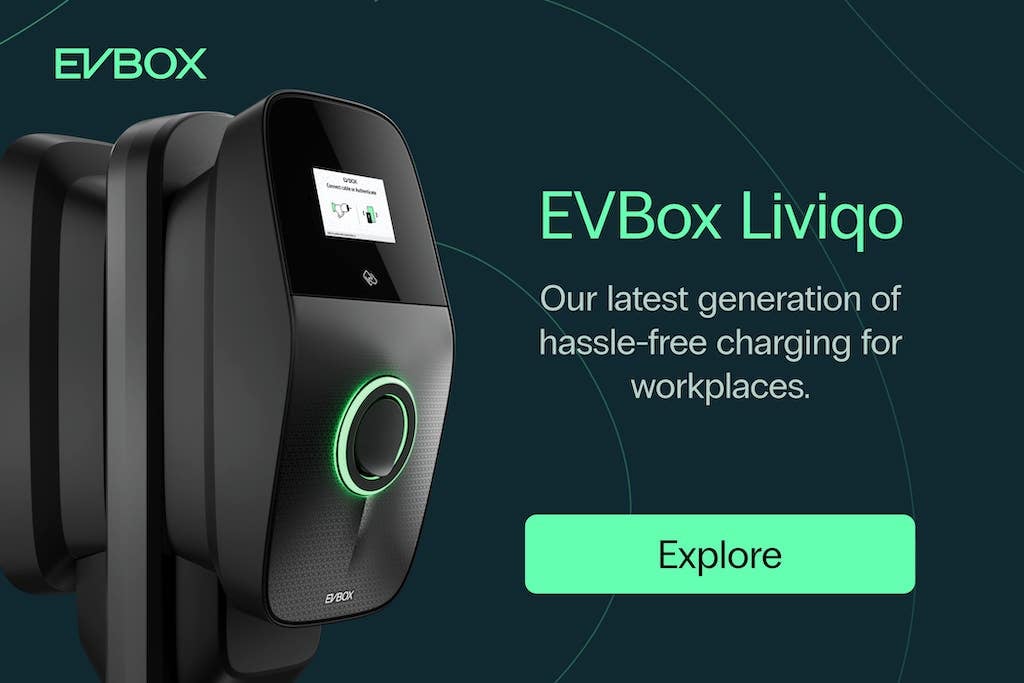
On average, AC workplace EV chargers tend to cost around €1,300 per charge port (excluding installation costs).
However, there are many factors that determine how much a workplace electric vehicle (EV) charger costs exactly, including its brand and model, functionalities, and the often underestimated installation costs that come with individual wiring and cabling of the stations.
As a rule of thumb, installation costs are usually between 60-80% of the total costs and can even run up to tens of thousands if you’re looking to install a bigger network of 5, 10, or 25 charging stations.
Please note: all the above information relates to AC charging stations (there is a big difference between AC and DC charging stations).
DC (fast) charging stations are in a completely different category as they tend to cost around €50,000 per station (excluding installation costs that are usually between 30-50% of the total station purchase price).
For the sake of clarity, this article will focus on AC charging only.
However, If you want to learn more about DC charging stations, please take a look at our free DC guides: “Everything your business needs to know about DC charging”, or “15 questions to answer before investing in DC charging”.
Employees are going electric

Electric vehicle sales have reached a new record in 2022, confirming the trend toward electric mobility. If you’ve looked around your office’s parking lot recently, you’ve probably noticed an increasing share of your employee’s cars are now EVs.
But the workplace isn’t just a place for employees to park: Increasingly, EV drivers are expecting to be able to charge wherever they go, including at work. In fact, the workplace is already one of the most popular charging locations, with 34 percent of EV drivers regularly charging at work.
Of course, meeting employee needs is important, but installing EV chargers comes at a cost. So how do you know how much your installation will cost, and how can you ensure that you’re getting the most value out of it? Let’s take a closer look at the costs of a workplace EV charger below.
The costs of a workplace EV charger

Generally speaking, there are different aspects of costs, and for the sake of clarity, we’ve divided them up into:
Upfront Costs of workplace EV charging stations
Upfront costs are likely the first to come to mind when thinking about EV chargers. These include the actual price of the equipment and labor costs for surveying and preparing the site, and purchasing the charger.
Price of workplace EV charging station
Generally speaking, and taking a ballpark average, a typical AC workplace charging station usually costs around €1,300 per charging port (excluding installation costs).
The cost of a charging station varies greatly and is determined by its features and capabilities, such as its charging speed and power output, the number and type of sockets, the length of the cable, and any connectivity or smart charging features.
Installation costs of workplace EV charging stations
Installation costs often represent the biggest share out of an investment in EV charging. On average, AC charging station installation costs usually represent between 60-80% of the total costs and can even run up to tens of thousands if you’re looking to install a bigger network of 5, 10, or 25 charging stations.
Depending on your location, purchase, and installation costs can be higher or lower, for instance, due to differences in wages and the complexity of your site. Consider as well the government incentives or rebates you can leverage, which can help you offset some of the initial cost.

Ongoing costs of workplace EV charging stations
Installing a charger may be the bulk of its cost, but as with any device, some maintenance is necessary to keep it in top shape. While charging stations are built to be sturdy and long-lasting, frequent use can wear out some parts or leave others in need of a scrub.
Maintenance cost of workplace EV charging stations
In essence, there’s not a lot of maintenance required, although a yearly check-up of stations is recommended to avoid issues in the future and identify parts that need replacement, such as broken cables or damaged sockets.
Instead of regular one-off service appointments, it’s often worth opting into a maintenance plan or service agreement with a trusted provider. This will guarantee optimal uptime by identifying and fixing any issues early on, offering peace of mind and freedom from unexpected costs.
Operational costs of workplace EV charging stations
Beyond maintenance, consider as well the costs of running the chargers, including the electricity used. Taking the average electricity price per kWh in the U.S. of $0.15 and €0.25 in Europe, it would cost around $8.68 (or €14.88) to fully charge a Nissan Leaf (64 kW) or $14 (or €24) for a Tesla Model S (100 kW).
Assuming you have space for 10 cars, and that each one would charge for a full 8-hour workday, it would cost you $86.80 (€148.80) to charge 10 Nissan Leafs or $140 ($240) for 10 Tesla Model Ss.
Of course, you don’t have to bear the whole cost of the electricity, and there are various business models for offering EV charging at the workplace. This brings us to our next point.

ROI and cost savings of workplace EV chargers
Installing EV charging at your workplace may initially be an expense, but within a few years, it can actually yield cost savings and even be a source of revenue, depending on the business model you’ve opted for.
Broadly speaking, you can either offer EV charging for free to your employees as a complimentary benefit or charge users a fee for using the station, in which case you can offer a discounted rate to employees while other users pay the full price.
If you decide to adopt the second model, you might find that after a few years, your EV chargers aren’t just breaking even – they are starting to generate a profit. This is especially true if you open up your charging stations to customers or the general public, essentially putting your business “on the map” as a public charging location.
If you operate a fleet of vehicles, installing EV charging stations can unlock further savings by providing transparency and control over charging costs, ensuring you opt for the most affordable option.

Workplace EV charger ROI: an example
Let’s illustrate how you might generate revenue from operating EV chargers at your workplace by looking at an example. Suppose you’ve installed 5 charging stations at a cost of €16,500*, including installation.
Let’s assume your chargers are used 5 days a week, with an average charging session consumption of 25 kWh, and are open to both your employees and visitors for a fee.
- Employees benefit from a discounted rate of €0.45 per kWh,
- Visitors pay the market rate of €0.75 per kWh.
Supposing each charger is used once per day, and with an average of 3 employee sessions a day and 2 visitors a day, how much will it take you to break even on your investment?
Deducing the EU average electricity cost of €0.25 leaves you with a profit of €0.2* per kWh for employees and €0.5* per kWh for visitors. That means that you would generate €375* a month profit from employee charging and €625* per month from visitors.
- 5 chargers * 5 days a week * 3 employee sessions a day * 25 kWh * (€0.2 - €0.25) = €375
- 5 chargers * 5 days a week * 2 visitor sessions a day * 25 kWh * (€0.5 - €0.25) = €625
Adding the two profits together, the total profit per month will be €1,000.
With these figures, you would break even in a little over 16 months of operating the charging stations, and anything you earn beyond that point is pure profit for your organization.
Of course, you might find this to be higher or lower depending on the cost of your charging stations and their installation, their usage, the electricity prices in your region, and the prices you charge – if any.
If you would like to calculate the potential revenue you can make from EV charging in a little more detail, download our free EV charging revenue calculator*.
*These numbers are indicative for illustrative purposes only and do not reflect actual costs.

The importance of future-proofing your workplace EV charging investment
Of course, buying the charging station is a significant expense, but it’s worth keeping the long-term picture in mind to future-proof your investment.
For instance, you can prepare your location to easily allow you to add more stations in the future without having to redo their wiring, and increase power as the number or speed of charging stations increases.
Consider as well that EVs and EV chargers are constantly developing, here’s an overview of some current examples of important considerations to take into account:
EEBus compatibility
EEBus compatibility enables standardized energy management at the grid connection point and among energy-relevant devices—such as electric cars—inside the building.
Load balancing
Advanced Load balancing features prevent overcapacity by distributing the available capacity over all charging stations. This makes it an important smart charging feature for anyone that operates multiple charging ports at a location, especially if there is a limited power capacity.
ISO 15118 compatibility
ISO 15118 is the new international standard that provides a direct communication interface between chargers and EVs, this allows chargers to immediately recognize, identify, and connect to your car and start charging. Because of this, it can, for example, enable automated payments or billing.
OTA (Over-the-Air updates)
Thanks to the enhanced connectivity which makes charging stations “smart”, newer generations of charging stations have the ability to receive over-the-air updates. Over-the-air (OTA) updates are essentially the ability to download software updates or applications and services or troubleshoot challenges.

Workplace EV chargers: An investment in the future
Electric mobility is now a fact of life – it’s no longer a question if, but when your employees will purchase an electric vehicle.
Installing workplace EV chargers also has an impact beyond your direct bottom line.
By getting ahead of the curve and investing in electric vehicle charging infrastructure now, you can future-proof your organization and provide a high-value benefit that helps boost employee satisfaction, contribute significantly to your organization’s sustainability strategy, and can even be a direct source of profit.
By incentivizing employees to switch away from combustion engine vehicles, offering EV charging at work can even help with your talent acquisition efforts and make it easier to retain high-skilled employees by providing a highly sought-after benefit.
To learn more about how to build EV charging into your company’s portfolio, have a look at our in-depth guide. If you are ready to start installing EV charging at your workplace, have a look at our EV charging solutions here.
Related articles

EV charging load management and the importance of cluster load balancing
Electric vehicle (EV) charging stations can add a substantial load onto your building’s power supply, often requiring...

How to install EV chargers at the workplace?
Regardless of the type or model of charger you choose (or how much one costs), installing EV charging stations is...

What do workplace EV chargers cost?
On average, AC workplace EV chargers tend to cost around €1,300 per charge port (excluding installation costs)....
